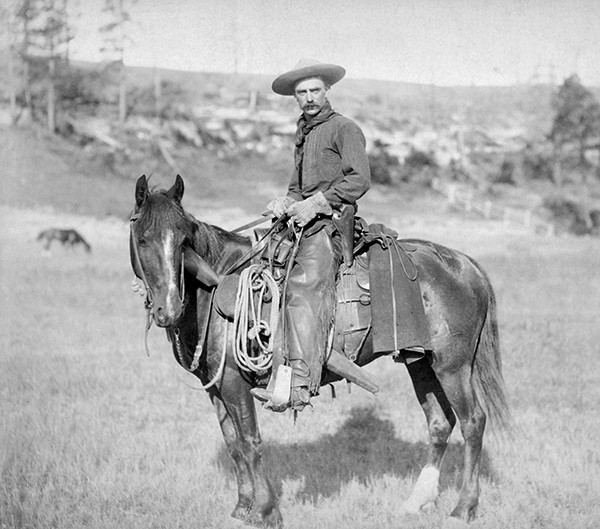
Above: An American cowboy photographed circa 1888.
While doing research for this story I was surprised to learn the era of the American cowboy was just 30 years – 1865-1895. These men were real cowboys, not like today’s ranch hands who go around in jeeps and helicopters etc.
Circa 1865 the big cities of the East Coast were teeming with people. And people need food and beef. This is when the cowboy enters our picture. At this time, big ranchers in Texas, Arizona, and New Mexico would round up thousands of longhorn cattle for the long, dangerous journey over 2.000 miles to Northern cities. This was an eye-watering two to three months trip. The trail boss would hire 25 young men, all around 21, to last the cruel, punishing and very dangerous journey up the Chisholm Trail.
Before the long trek, a truly amazing event took place. The head honcho would ask every cowboy to sing. Yes, to sing! He wanted soft baritone voices. He would pick two cowhands whose job was to circle the herd every night, singing sad cowboy songs to keep the herd calm. As they circled the herd, the cattle would lift their heads and emit a loud moo, as if to say “Thanks men, we feel safe now.” This must have been an astonishing sight.
The cowboy’s clothes were all fit for purpose; his wide-brimmed Stetson hat to shield his face from the burning sun; the bandana was multi-purpose as neck shield, sweat band and filter for nose and mouth in dust storms; cotton shirt; denim trousers with leather chaps for rough country; and a two-inch heel boot (the two-inch heel was a safety issue as it kept his feet in the stirrups).
Around his saddle he had a lariat, water canteen, a Winchester, Remington or Sharp rifle. At his rear was a blanket, cup, plate, knife, spoon and waterproof coat. And that was all a real cowboy owned.
At the end of their two to three months journey north the men were paid. The first job was a bath and shower, then shave and haircut and a set of new clothes. Next, they hit the saloons for drink, gambling and female company. The women in these saloons had a nasty, ugly life – used and abused. They looked dreadful; no teeth, unwashed – it was a horrific life. In the movies, Hollywood gave us Doris Day, Virginia Mayo and other attractive stars as bargirls. Even the cowboys looked perfect, as if they stepped out of a Louis Copeland shop window. The reality was far different. Most of the saloon girls died before they reached 30. Most were shot, stabbed or strangled by drunken louts, while others died of STDs. There were no happy endings for these sad young women.
By 1890 the era of real cowboys was almost over due to two events. The first was the invention of barbed wire. The ranchers laid down millions of miles of barbed wire and this was the end of open range. The second was the iron horse. By 1890 the train reigned supreme. By this time almost every town in America had a rail link, which meant the ranchers could load cattle on trains and get to the stockyards up North in 3-4 days instead of three months overland.
Today we have Dude Cowboys who go around in jeeps and motorbikes. They are a joke when compared to the real cowboys of 150 years ago. Yes, many were thugs, murderers etc, but let’s not forget the many decent men and women who stayed, worked hard and prospered. So may I say hail and farewell to the real cowboys.
By Noel Twamley

